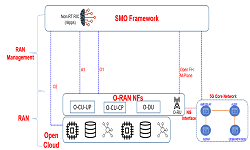Introduction
The SMO is an automation platform for Open RAN Radio Resources and known as Service Management and Orchestration (SMO).The specifications for SMO framework are defined by Open RAN Alliance. Hierarchically, it is a component of the OSS. The SMO platform support multiple deployment options to suit the end-user requirements e.g. it can deployed with distributed system, deployed on premises with telco-cloud as-a-Service etc.
SMO Framework
SMO Platform Architecture including other Open RAN componetn is shown in following figure. It is consist of Open Central Unit (O-CU), Open Distributed Unit (O-DU) functions, and near-real-time radio intelligent controller (Near RT-RIC) are defined as cloud-native virtualized functions which run on cloud infrastructure also known as the O-Cloud.
SMO framework oversees lifecycle management of network functions as well as O-Cloud. The SMO includes a non-real-time radio intelligent controller or Non-RT-RIC. The architecture defines various SMO interfaces, namely O1, O2, and A1, which allow the SMO to manage multi-vendor Open RAN networks. ORAN is standardizing means of extending the O1, A1 and R1 interfaces to enable a competitive ecosystem and quick time to market of new functionality.
According to O-RAN design specifications SMO includes:
- A design environment for rapid application development
- A common data collection platform for management of RAN data as well as mediation for O1, O2 and A1 interfaces
- Support for licensing, access control and AI/ML lifecycle management, together with legacy north-bound interfaces
- Existing OSS functions such as service orchestration, inventory, topology and policy control
- R1 interface to allow portability and lifecycle management of rApps. We believe that by supporting specific proprietary south-bound interfaces to third-party equipment management systems (EMS) the SMO would have the ability to automate existing, purpose built multi-vendor RAN as well as Open RAN networks.
SMO Interfaces
- R1 Interface: R1 interface operates towards multi-vendor rApps. It is designed to support portability of multi-vendor rApps and provides value-added services to rApp developers and solution providers. The interface enables Open APIs to be integrated in the SMO framework. It is a collection of services including service registration and discovery services, authentication and authorization services, AI/ML workflow services, and A1, O1 and O2 related services.
- A1 Interface: A1 interface is used for policy guidance. SMO provides fine-grained policy guidance such as getting User-Equipment to change frequency, and other data enrichments to RAN functions over the A1 interface.
- O1 Interface: SMO supports O1 interface for managing the operation and maintenance (OAM) of multi-vendor Open RAN functions including fault, configuration, accounting, performance and security management, software management, and file management capabilities.
- O2 Interface: O2 interface in SMO is used to support cloud infrastructure management and deployment operations with O-Cloud infrastructure that hosts the Open RAN functions in the network. O2 interface supports orchestration of O-Cloud infrastructure resource management (e.g., inventory, monitoring, provisioning, software management and lifecycle management) and deployment of the Open RAN network functions, providing logical services for managing the lifecycle of deployments that use cloud resources.
- M-plane: For, SMO supports NETCONF/YANG based Open FrontHaul M-Plane as an alternative to O1 interface to supporting multi-vendor O-RU integrations. Open FrontHaul M-plane supports the management features including startup installation, software management, configuration management, performance management, fault management and file management.
SMO for RAN Optimization
SMO framework can be used for RAN Optimization with the help of Non-RT RIC and rApps. The Non-RT RIC enables the intelligent RAN optimization in non-real-time by providing policy-based guidance using data analytics and AI/ML models. The non-RT RIC can leverage SMO solutions such as data collection and provisioning services of O-RAN nodes.
Further more rApps being modular applications can leverage the functionality exposed by the non-RT RIC and SMO Framework over the R1 interface to perform multi-vendor RAN optimization and assurance.
Having the Open interfaces architecture the inter-operability between the SMO, RAN functional entities and applications can be easily achieved. Another benefit of open architecture is that the new application can be easily integrated in the eco-system and rApps can be developed and delivered by any third party or Service Provider can build their own rApps.
References:
Related Posts:

